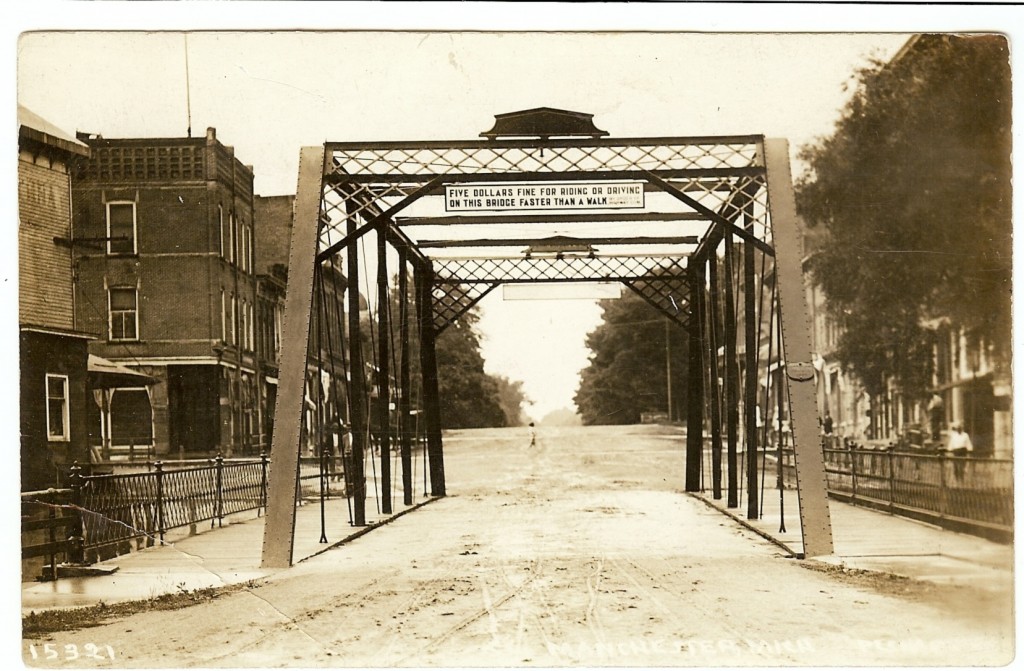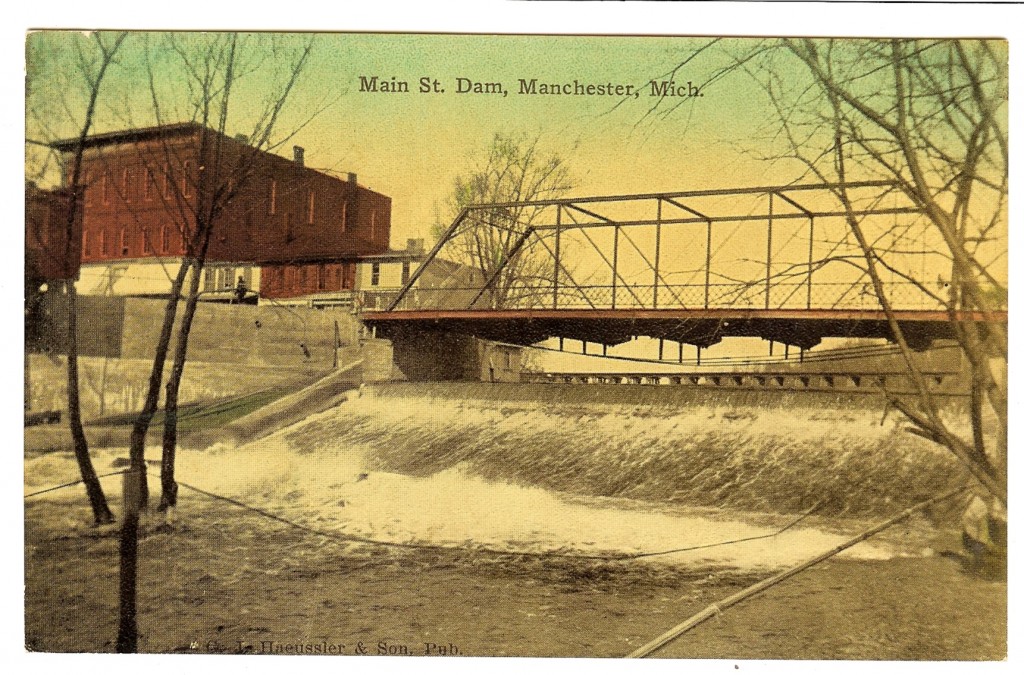The Five Lives of the Main Street Bridge, Part Three of Five
Bridge #3 – The 1886 Iron Bridge
On April 8, 1886, the Village Council inspected the Exchange Place bridge with a view to rebuilding or repairing it. Blosser again noted that an iron bridge would be just the thing. A special election for July 27, 1886 was called for. Highway Commissioner Case presented arguments for taxpayers to consider, providing cost estimates for repair vs. new construction. The 1876 bridge and its underlying structure, some of which dated to 1833, was determined to be in very bad shape and costly to repair, and that an iron bridge was the preferred solution. The Canton Bridge Co. of Canton, Ohio, through its local agent Mr. R. D. Wheaton based in Charlotte, Michigan, was selected as the provider of the iron bridge. William Burtless was awarded the general contractor position.
Blosser wrote a full column editorial praising the council’s decision to construct an iron bridge on stone abutments, noting: “The Enterprise has supposed that every man, woman or child who have crossed the bridge on Exchange Place were aware of its unsafe condition. Certainly every boy who skates or swims and has been under the bridge knows that the timbers are rotting away, and that the structure has settled on the east end, and that the stringers and planking are in a dilapidated condition is apparent to everyone. An examination proves such to be the case, and the embankment at either end is crumbling away and careening piles offer but scant support for the timbers. Blosser polled many of the wealthiest land owners (hence tax payers), and found unanimous support for the new iron bridge.
On July 27, 1886, a special election was held at Fred Briegel’s shoe factory to vote “new bridge or no new bridge”, and on raising $3,000 by tax ($2.25 per $1,000 of assessed valuation) for the purpose of building an iron bridge across the river upon new stone abutments. Upon passage of the election proposal, the Highway Commissioner immediately condemned the Exchange Place bridge as unsafe, and noted that those who passed over did so at their own risk.
Robert Blake was contracted to build the stone and cement footings and abutments, and work began in September 1886. The street level at the bridge was built up six feet from the old grade. His construction crews discovered wooden structures 12 feet below the surface of the road dating from circa 1850, when a flood broke through around the west end of the bridge/dam, and threatened to cause major damage to the mill – old-timers recalled that farmers came in with loads of dirt and lumber to repair the damage to the road and dam.
The delivery of the iron bridge from Canton Bridge Co. was delayed until late November, causing citizen concern and anger over the inconvenience of the old wooden bridge having been removed, with no temporary passage across the mill pond installed. The financing also came under question at a Council meeting November 18, 1886: “Fifty citizens who ‘pecked away’ and asked questions have brought to light some valuable secrets which had been hidden. The town board had borrowed of B. G. English $2,400. The note was for 3 years. They intended to use some of the money to pay for the iron bridge but the (citizens) ‘committee’ made it so warm that they returned the money to English and now it is likely that our taxpayers will have the great satisfaction and pleasure of paying the whole sum by way of taxes this year. The Board acted unwisely but they intended to make it easier for the taxpayers.”
But on November 25, 1886, Blosser reported: “The new iron bridge on Exchange Place is finished and so far as we are able to learn gives general satisfaction. Some people would have had it a few feet wider, others think it is wide enough. Opinions differ in many respects, but taking it all in all we think that the bridge is sufficient for our needs, looks well and will be a joy forever.” That is, until heavy automobile traffic came along 40 years later.
Controversy was not over, however. On January 27, 1887, Blosser wrote: “The ‘kick’ made by several of our citizens last fall which resulted in the calling of an indignation meeting from the long delay in the erection of the bridge has lasted much longer than anticipated. A number of the heavy taxpayers of this township have refused to pay their tax, claiming that the bridge tax was improperly spread upon the roll. The township treasurer responded that he must have their tax or their property, and as attorneys were consulted we presume there will be trouble.” This must have faded away as no further reporting was noted in the Enterprise on this issue.
Figure 3 shows a view of the 1886 iron bridge. The sign reads “Five Dollars Fine for Riding or Driving On This Bridge Faster Than A Walk.”
Figure 4 shows a side view of the iron bridge.
On April 22, 1897, responding to citizen and shopowner complaints, the Village Council passed an ordinance prohibiting bicycle riding on the sidewalks and the Exchange Place bridge walkways, when bicycle fever swept Manchester. Frequent bridge planking repairs were noted throughout the years. Kimble & Schmid performed this work, and noted that it was becoming more difficult to find suitable logs in 18 foot lengths from which to create planking for the bridge. In September 1908, the bridge roadway planking was replaced with cement, but the walkways were left as planking. In the mid-late 1920s, a large white canvas was hung from the girders to be used as a movie screen, when public movies were shown midweek to attract customers to town. At other times, a portable gazebo was set up near the bridge for band concerts.
Click HERE to read Part 4 of The Five Lives of the Main Street Bridge.










You must be logged in to post a comment Login